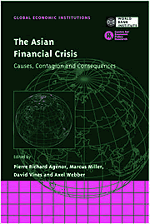Book contents
- Frontmatter
- Contents
- List of figures
- List of tables
- Preface
- List of conference participants
- Acknowledgements
- List of abbreviations and acronyms
- Introduction
- Part One General Accounts
- Part Two Theoretical Contributions
- 5 Capital markets and the instability of open economies
- Discussion
- 6 Volatility and the welfare costs of financial market integration
- Discussion
- 7 A theory of the onset of currency attacks
- Discussion
- Part Three Contagion
- Part Four Policy Responses
- Index
Discussion
from Part Two - Theoretical Contributions
Published online by Cambridge University Press: 26 February 2010
- Frontmatter
- Contents
- List of figures
- List of tables
- Preface
- List of conference participants
- Acknowledgements
- List of abbreviations and acronyms
- Introduction
- Part One General Accounts
- Part Two Theoretical Contributions
- 5 Capital markets and the instability of open economies
- Discussion
- 6 Volatility and the welfare costs of financial market integration
- Discussion
- 7 A theory of the onset of currency attacks
- Discussion
- Part Three Contagion
- Part Four Policy Responses
- Index
Summary
In their chapter 6, Agénor and Aizenmann develop a theoretical model of the effects of opening up the financial markets of a country. They explore the effects on the returns of domestic firms, banks and savers, and explore the amount of investment undertaken and the effects on welfare. The chapter begins with a model in which the domestic economy can provide a fixed supply of saving at a constant reservation price, which meets a fixed domestic demand for funds, well below domestic saving. This is the central case which occupies most of the exposition and provides most of the chapter's insights. The chapter goes on to consider two extensions. One allows for an upward-sloping supply curve of funds and heterogeneity of projects in terms of their expected returns, and the other allows additionally for congestion externalities. These two cases allow the opening up of financial markets to affect the amount of investment that takes place in the economy. Congestion externalities increase the likelihood that internationalisation will lead to excessive investment which reduces welfare.
The analysis assumes that there is asymmetric information between banks and the firms to which they lend, in that the firms alone discover costlessly the returns on their investments, which are random variables. While the banks can also discover the returns to investment projects, monitoring is costly, and is carried out only when firms default on loans. However, although asymmetric information and costly monitoring are assumed, there is no room for moral hazard or adverse selection in the model.
- Type
- Chapter
- Information
- The Asian Financial CrisisCauses, Contagion and Consequences, pp. 225 - 229Publisher: Cambridge University PressPrint publication year: 1999



